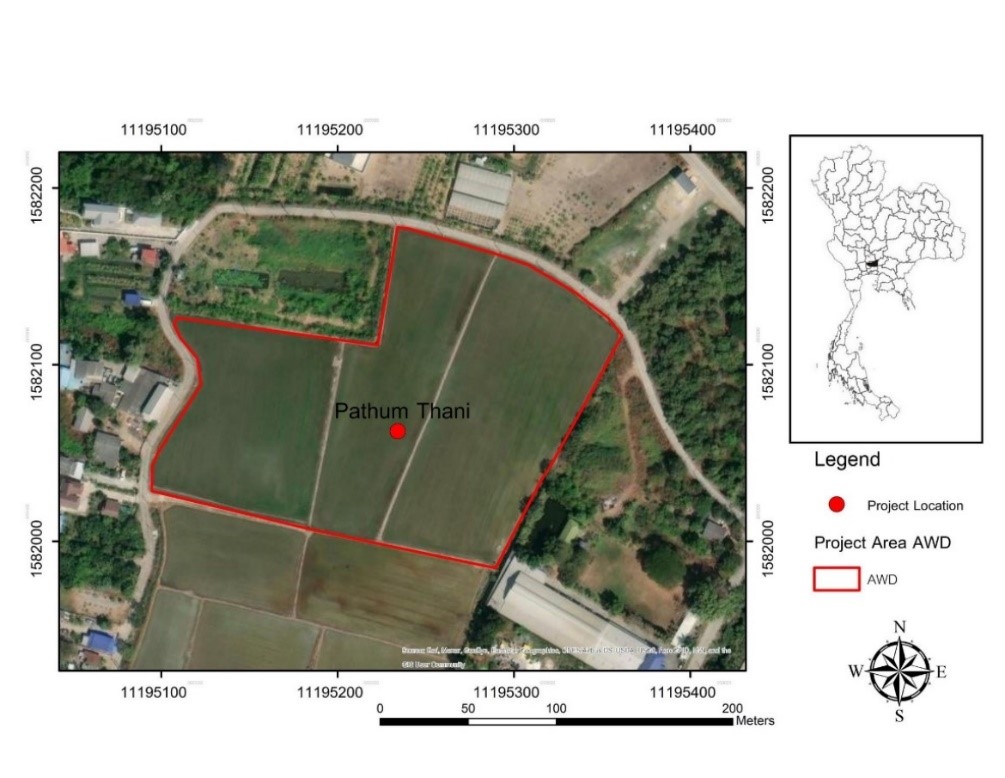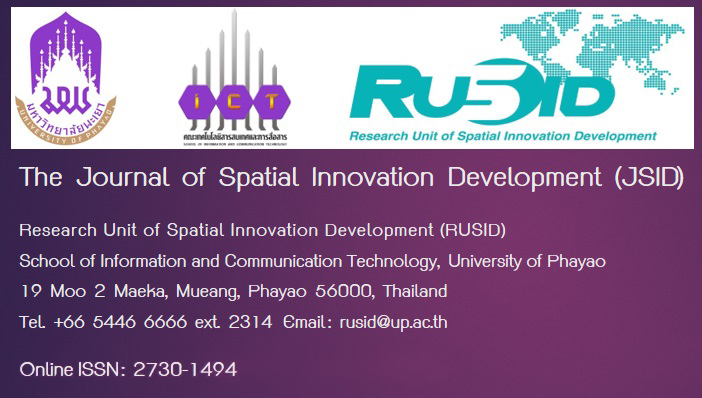Climate Change Mitigation using Alternate Wetting and Drying Methods to Reduce Greenhouse Gas Emissions
Keywords:
Alternate wetting and drying, Methane, Carbon dioxide, Carbon credit, Sustainable Development Goals (SDGs)Abstract
The problem of climate change, or better known as global warming, is becoming a major problem in the world. Carrying out project activities to reduce greenhouse gas emissions from the agricultural sector is one way to help alleviate climate change that is getting more severe every year. The objective of this research is 1) Preparing the rice fields and creating an irrigation system in the rice fields to be Alternate Wetting and Drying, 2) Compare costs before and after Alternate Wetting and Drying, 3) Compare the amount of water used before and after Alternate Wetting and Drying, 4) Compare the amount of fertilizer used before and after Alternate Wetting and Drying, 5) Compare rice production before and after Alternate Wetting and Drying and 6) Analyze the amount of greenhouse gases that can be reduced from Alternate Wetting and Drying farming under the Thailand Voluntary Emission Reduction Program (T-VER) using advanced standards (Premium T-VER). The procedures of this study were carried out according to the 6 objectives mentioned above. Results of the study of Alternate Wetting and Drying in the study area of 20 rai, located at Chao Nuea Road 5, Chiang Rak Yai Subdistrict, Sam Khok District, Pathum Thani Province. It was found that production costs decreased by 19.39 percent, water use decreased by 90 percent, fertilizer use decreased by 10 percent, production increased by 44.5 percent. This study was able to reduce greenhouse gas emissions from project activities (15 years) by 100 tons of carbon dioxide equivalent (tCO2e), an average of 6.7 tons of carbon dioxide equivalent (tCO2e) per year. When calculated as the amount of carbon credits from the operation area that excludes fertilizer use, it was found that there was a total of 100 tons of carbon dioxide equivalent (tCO2e) for 15 years.
References
กรมการข้าว. (ม.ป.ป.). การทำนาแบบเปียกสลับแห้ง. จาก https://webold.ricethailand.go.th/web/index.php/ mactivities/6292-2019-07-08-14-27-58.
กระทรวงเกษตรและสหกรณ์. (2558). คู่มือการทำนาแบบเปียกสลับแห้งแกล้งข้าว ภายใต้โครงการจัดทำแปลงสาธิตการทำนาแบบเปียกสลับแห้ง. จาก https://water.rid.go.th/waterm/template/manager/FProjectMAC/portfolio/58.pdf.
จิตติวรรณ บำรุงบุตร พงษ์เทพ หาญพัฒนากิจ อำนาจ ชิดไธสง สุขุมาภรณ์ แสงงาม และศุภิกา วานิชชัง. (2563). ประสิทธิภาพการจัดการน้ำด้วยวิธีแบบเปียกสลับแห้งต่อการเจริญเติบโตและผลผลิตข้าว. วารสารมหาวิทยาลัยศรีนครินทรวิโรฒ (สาขาวิทยาศาสตร์และเทคโนโลยี), 12, 10-22.
นวลละออง อรรถรังสรรค์. (2558). กระบวนการสร้างเสริมการบริหารจัดการธนาคารข้าว และการลดต้นทุนในการผลิตข้าว กรณีศึกษา: บ้านหินปูน ตำบลเขวาใหญ่ อำเภอกันทรวิชัย จังหวัดมหาสารคาม. วารสารวิจัยเพื่อการพัฒนาเชิงพื้นที่, 7, 16-33.
ทีดีอาร์ไอ .(2566). ทำไมต้องทำนาแบบเปียกสลับแห้ง. จาก https://tdri.or.th/2023/08/alternative-wetting-and-drying-rice/.
สุภชัย ปิติวุฒิ .(ม.ป.ป.). ระบบผลิตเปียกสลับแห้งแกล้งข้าว. จาก https://www.nstda.or.th/nac/2013/download/presentation/NAC2013_Set1/CC-305-02-PM/Supachai_Document.pdf.
องค์การบริหารจัดการก๊าซเรือนกระจก. (2559). T-VER คืออะไร. จาก https://ghgreduction.tgo.or.th/th/ about-tver/t-ver.html.
องค์การบริหารจัดการก๊าซเรือนกระจก. (2563). โครงการ T-VER มาตรฐานขั้นสูง (Premium T-VER). จาก https://ghgreduction.tgo.or.th/th/about-premium-t-ver/about-premium-t-ver-project. html.
องค์การบริหารจัดการก๊าซเรือนกระจก. (2564). ค่าศักยภาพในการทำให้เกิดภาวะโลกร้อน (Global Warming Potential: GWP) สำหรับโครงการ T-VER. จาก https://ghgreduction.tgo.or.th/th/download-tver/120-tver-gwp-emission-factor/2692-global-warming-potential-gwp-t-ver.html.
อารยา จันทร์สกุล. (2561). Overtourism ผลกระทบและแนวทางการจัดการเพื่อความยั่งยืน. จาก https://www.bot.or.th/Thai/MonetaryPolicy/Southern/ReasearchPaper/Overtourism.pdf.
Brick, C., Bosshard, A., & Whitmarsh, L. (2021). Motivation and climate change: A review. Current Opinion in Psychology, 42, 82-88.
Bruine de Bruin, W., Rabinovich, L., Weber, K., Babboni, M., Dean, M., & Ignon, L. (2021). Public understanding of climate change terminology. Climatic Change, 167(3), 37.
Brulle, R. J. (2021). Networks of opposition: A structural analysis of U.S. climate change countermovement coalitions 1989– 2015. Sociological Inquiry, 91(3), 603-624.
Carrijo, D. R., Lundy, M. E., and Linquist, B. A. (2017). Rice yields and water use under alternate wetting and drying irrigation: A meta-analysis, Field Crop. Res., 203, 173–180.
Dahlgreen, J., & Parr, A. (2024). Exploring the Impact of Alternate Wetting and Drying and the System of Rice Intensification on Greenhouse Gas Emissions: A Review of Rice Cultivation Practices. Agronomy, 14, 378.
Dong, N.M., K.K. Brandt, J.Sørensen, N.N.Hung, C.V.Hach,, P.S.Tan & T.Dalsgaard. (2012). Effects of alternateing wetting and drying versus continuous flooding on fertilizer nitrogen fate in rice fields in the Mekong Delta, Vietnam. Soil Biology & Biochemistry, 47, 166-174.
International Rice Research Institute. (2021). Rice straw. Rice knowledge bank. Laguna, the Philippines. knowledgebank. Form http://www.knowledgebank.irri.org/step-by-step-production/ postharvest/rice-by-products/rice-straw.
Manabe, S. (2019). Role of greenhouse gas in climate change. Tellus A Dyn. Meteorol. Oceanogr, 71, 1–13.
Maneepitak, S., Ullah, H., Paothong, K., Kachenchart, B., Datta, A., Shrestha, R.P. (2019). Effect of water and rice straw management practices on yield and water productivity of irrigated lowland rice in the Central Plain of Thailand. Agric. Water Manag, 211, 89–97.
Sahu, R., Chaurasiya, A., Kumar, R., & Sohane, R. K. (2023). Alternate wetting and drying technology for rice production. Indian Farming, 73(3), 11-13.
Samek, J.H., Skole, D.L., Butthep, C., Navanugraha, C., Uttaruk, P., Laosuwan, T. (2011). Inpang carbon bank in northeast Thailand: A Community Effort in Carbon Trading from Agroforestry Projects. In Carbon Sequestration Potential of Agroforestry Systems; Springer: Berlin/Heidelberg, Germany, 263–280.
Sugsaisakon, S., Kittipongvises, S. (2021). Citywide Energy-Related CO2 Emissions and Sustainability Assessment of the Development of Low-Carbon Policy in Chiang Mai, Thailand. Sustainability, 13, 6789.
Teerawong Laosuwan & Yannawut Uttaruk. (2016). Estimating Above Ground Carbon Capture Using Remote Sensing Technology in Small Scale Agro Forestry Areas. Agriculture & Forestry, 62(2), 253-262.
Tian, J., Shan, Y., Zheng, H., Lin, X., Liang, X., & Guan, D. (2019). Structural patterns of city-level CO2 emissions in Northwest China. J. Clean. Prod, 223, 553–593.
Uttaruk, Y., & Laosuwan, T. (2020). Methods of Estımatıon for Above Ground Carbon Stock in Nongbua-nonmee Communıty Forest, Maha Sarakham Provınce, Thailand. Poljoprivreda i Sumarstvo, 66(3), 183-195.
Vries, M.E., Rodenburg, J., Bado, B.V., Sow, A., Leffelaar, P.A. and Giller, K.E. (2010). Rice production with less irrigation water is possible in a Sahelian environment. Field Crops Research, 116, 154-164.
Wu, K., Li, W., Wei, Z., Dong, Z., Meng, Y., Lv, N., and Zhang, L. (2022). Effects of mild alternate wetting and drying irrigation and rice straw application on N2O emissions in rice cultivation. SOIL, 8, 645–654.
Yang, J.C., Zhang, H., & Zhang, J.H. (2012). Root morphology and physiology in relation to the yield formation of rice. Journal of Integrative Agriculture, 11(6), 920-926.
Yannawut Uttaruk & Teerawong Laosuwan. (2019). Development of Prototype Project for Carbon Storage and Greenhouse Gas Emission Reduction from Thailand’s Agricultural Sector. Sains Malaysiana, 48(10), 2083–2092.
Yao, F., Huang, J., Cui, K., Nie, L., Xiang, J., Liu, X. (2012). Agronomic performance of highyielding rice variety grown under alternate wetting and drying irrigation. Field Crops Research, 126, 16-22.
Ye, Y., Liang, X., Chen, Y., Liu, J., Gu, J., & Guo, R. (2013). Alternate wetting and drying irrigation and controlled-release nitrogen fertilizer in late-season rice. Effects on dry matter accumulation, yield, water and nitrogen use. Field Crops Research, 144, 212–224.





